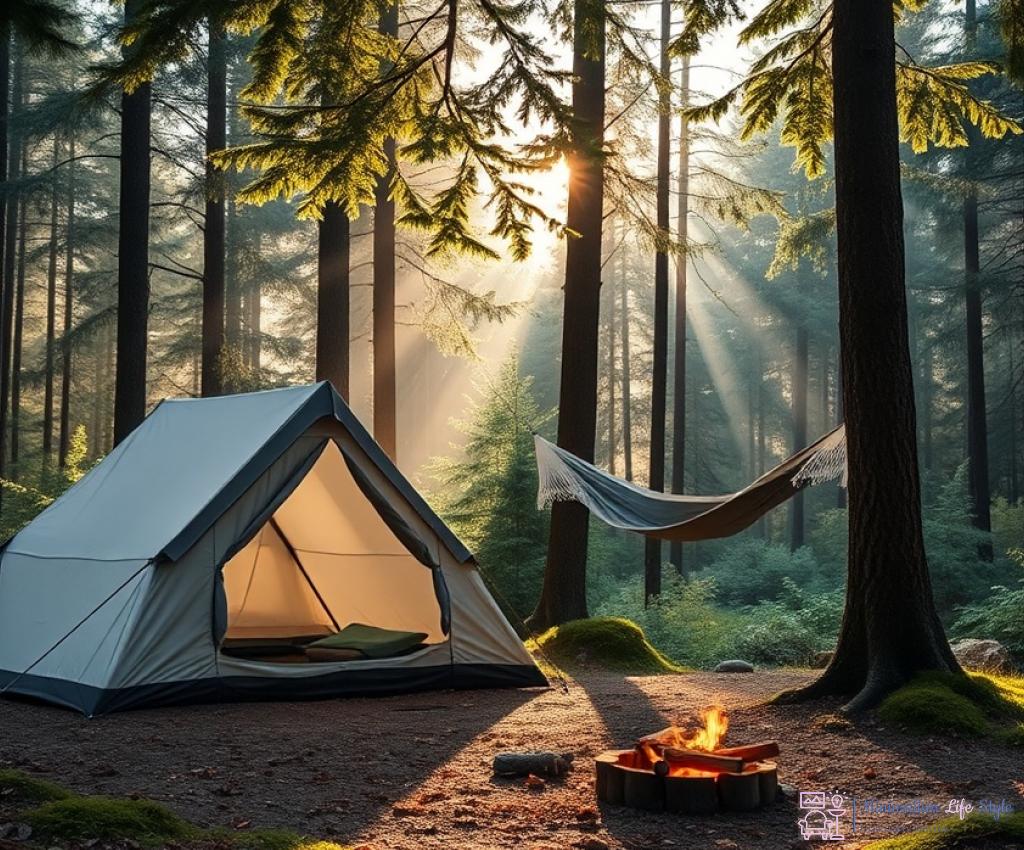Choosing the Right Shelter: Minimalist Tents and Hammocks

Embracing the Outdoors with Minimalist Shelters
When it comes to camping, the right shelter can make or break your experience. For those who lean towards a minimalist lifestyle, choosing between tents and hammocks can be a significant decision. Both options offer unique benefits, but understanding what each provides is crucial for a successful outdoor adventure. Let’s dive into the key factors that can help you make an informed choice.
The Great Tent vs. Hammock Debate
Choosing between a tent and a hammock often boils down to personal preference, the type of camping you plan to do, and the environment you’ll be in. Tents offer a more enclosed space, protecting you from the elements, while hammocks provide a lightweight and versatile sleeping solution that can be set up almost anywhere. Here’s a look at how they compare:
| Feature | Tent | Hammock |
|---|---|---|
| Weight | Heavier, depending on the type | Lightweight and portable |
| Setup Time | 5-15 minutes | 2-5 minutes |
| Protection from Elements | Good, with rainfly options | Limited, requires tarp for rain |
| Comfort | Varies, can be cramped | Highly comfortable, but personal preference |
| Space | More space for gear | Less space, ideal for one |
Essential Considerations for Your Camping Style
Before making a decision, consider your camping style and the environments you will face. Are you heading into dense forests where trees are abundant? A hammock might be your best bet. However, if you’re planning on camping in open fields or unpredictable weather, a minimalist tent could provide the protection and comfort you need. Remember that both options can coexist in your outdoor arsenal, allowing you to adapt to different situations. Here’s a list of essential factors to keep in mind:
- Weight: Ensure your shelter is lightweight for easy transport.
- Setup: Opt for a shelter that you can set up quickly.
- Weather Resistance: Choose materials that can withstand the elements.
- Space: Consider how much room you need for yourself and your gear.
- Comfort: Test both options to see what feels best for you.
Essential Cooking Gear: Lightweight Solutions for Outdoor Meals
When venturing into the great outdoors, the joy of cooking can enhance your experience significantly. However, traditional cooking gear can be bulky and cumbersome, which contradicts the minimalist ethos many campers embrace. The key to an enjoyable outdoor cooking experience lies in selecting the right lightweight tools that will allow you to prepare delicious meals without weighing you down. Let’s explore some essential cooking gear that aligns perfectly with a minimalist camping approach.
Compact Cooking Systems for Effortless Meal Preparation
In the world of outdoor cooking, compact cooking systems have gained immense popularity. These all-in-one solutions typically include a stove, pot, and sometimes even a fuel source, all designed to be lightweight and easily storable. Investing in a quality system not only reduces the number of separate items you need to carry but also streamlines your cooking process. For instance, a system like the Jetboil or MSR PocketRocket allows you to boil water quickly, making it perfect for instant meals, soups, or coffee on a chilly morning. With these systems, you can enjoy the comfort of hot meals without the hassle of traditional cooking gear.
Multi-functional Utensils: The Swiss Army Knife of Cooking Gear
One of the best strategies in minimalist camping is to choose multi-functional utensils. Instead of packing a separate knife, spoon, and fork, consider a spork or a folding knife that can serve multiple purposes. Not only does this save space, but it also reduces the weight of your pack. Additionally, look for pots that come with integrated measuring cups or lids that double as frying pans. Such items maximize utility while minimizing the need for extra gear. This approach ensures that every tool in your cooking kit has a purpose, aligning seamlessly with the minimalist philosophy of ‘less is more.’
Ultimately, the essence of minimalist camping lies in making thoughtful choices that enhance your outdoor experience. By focusing on essential cooking gear that is both lightweight and multifunctional, you can savor the joys of cooking in nature without the burden of unnecessary items. Embracing this approach not only lightens your load but also opens up new possibilities for culinary creativity in the wild.
Backpacking Basics: The Art of Packing Light
Mastering the Essentials for a Light Load
Backpacking, with its promise of adventure and connection to nature, can often feel daunting when it comes to deciding what to bring. However, embracing a minimalist approach allows you to focus on what truly matters. The art of packing light is not just about reducing weight; it’s about maximizing your experience in the great outdoors. By thoughtfully curating your gear, you can maintain mobility, efficiency, and enjoyment throughout your journey.
Prioritizing Versatility and Functionality
When selecting your backpacking gear, consider items that offer versatility and functionality. For example, a multi-purpose jacket that serves as both a windbreaker and an insulating layer can save space in your pack. Similarly, lightweight clothing made from moisture-wicking materials can be layered for warmth while remaining breathable during daytime hikes. This approach ensures that every piece of gear you carry serves multiple purposes, enhancing your experience without burdening you with excess weight.
Streamlining Your Packing Strategy
Understanding how to effectively pack your gear is just as critical as the items you choose. Begin by categorizing your essentials into must-haves and nice-to-haves. This method not only clarifies what you need but also helps you resist the temptation to overpack. As you load your backpack, place heavier items closer to your back for better weight distribution, and utilize compression sacks to minimize bulk. This strategic packing enables you to maintain balance and comfort, letting you navigate trails with ease.
Clothing Essentials: Versatile Layers for Every Adventure
When it comes to camping, your clothing choices can significantly impact your comfort and enjoyment in the great outdoors. Adopting a minimalist approach to your wardrobe allows you to pack efficiently while ensuring you are well-prepared for a variety of weather conditions. Versatile layers are key to achieving this balance, providing you with the flexibility to adapt to changing environments without the bulk of unnecessary items.
Layering for Success: The Power of Versatility
At the heart of an effective camping wardrobe is the concept of layering. Each layer serves a distinct purpose, allowing you to regulate your body temperature and stay comfortable throughout your adventure. Start with a moisture-wicking base layer that pulls sweat away from your skin, keeping you dry during strenuous hikes. Look for materials like merino wool or synthetic blends that provide warmth without adding weight.
The next layer should be an insulating option, such as a lightweight fleece or down jacket. This layer traps heat, providing warmth during chilly evenings or at higher altitudes. The beauty of choosing a packable insulation piece is its ability to compress into a small size when not in use, maximizing space in your backpack. Finally, a durable and breathable outer layer is essential for protection against wind and rain. Consider a lightweight, waterproof jacket that can easily be stored when the weather is fair.
Choosing the Right Footwear: Comfort Meets Functionality
Your choice of footwear is another critical aspect of a minimalist camping wardrobe. Aim for shoes that strike a balance between support, weight, and versatility. Hiking shoes or lightweight boots made from breathable materials can provide the necessary grip and stability on various terrains while remaining comfortable for extended wear. If you’re planning on crossing streams or encountering wet conditions, consider shoes that dry quickly and have good drainage capabilities.
Additionally, don’t overlook the importance of moisture-wicking socks. A good pair can prevent blisters and ensure your feet remain dry and comfortable during long hikes. Remember, the right footwear can make a world of difference, allowing you to focus on the beauty of your surroundings rather than discomfort.
In conclusion, embracing a minimalist approach to your camping clothing ensures that you are well-equipped for any adventure without the burden of excess weight. By carefully selecting versatile layers and functional footwear, you can navigate through various conditions with ease and grace. The outdoors is calling, and with the right clothing essentials, you’ll be ready to answer!
Navigating with Less: Must-Have Tools for the Trail
When you venture into the wilderness, having the right navigation tools can not only enhance your experience but also ensure your safety. Embracing a minimalist camping ethos doesn’t mean sacrificing essential equipment; rather, it means selecting tools that are lightweight, efficient, and multifunctional. With the right gear, you can confidently explore the great outdoors without being weighed down by unnecessary items.
Mapping Your Journey: The Power of Compact Navigation Tools
In an age where technology is at our fingertips, many campers may rely solely on their smartphones for navigation. However, while a smartphone can be a useful tool, it’s crucial to carry a physical map and compass as backups. These classic navigation tools are not only lightweight but also completely independent of battery life, ensuring you can always find your way. A compact folding map of your route can provide a broader perspective of the terrain, while a reliable compass will help you orient yourself and stay on course even in dense woods or unfamiliar areas.
Tech Meets Tradition: Integrating GPS with Minimalism
For those who appreciate the advantages of technology, a compact GPS device can be a game-changer. Unlike your smartphone, a dedicated GPS unit is often built for rugged use, featuring longer battery life and enhanced durability against the elements. When combined with your traditional tools, you gain the best of both worlds. Consider models that offer additional features such as barometric altimeters and built-in weather tracking to further enhance your outdoor experience. This way, you can navigate with confidence, adapting to changing conditions while still adhering to a minimalist approach.
Lightweight Tools for Precision Navigation
Aside from traditional maps and GPS, there are a few other lightweight navigation aids that can significantly contribute to your outdoor toolkit. A small, portable altimeter can help you monitor changes in elevation, which is particularly useful in mountainous regions. Additionally, a simple whistle not only serves as a signaling device in emergencies but can also assist in navigation through sound, especially in foggy conditions. When every ounce counts, these small, multifunctional tools can make a significant difference in your overall hiking experience. As you prepare for your next adventure, remember that navigating with less doesn’t mean compromising on safety or functionality. With thoughtful selections of essential tools, you can traverse trails with ease, allowing you to immerse yourself in the beauty of nature without the burden of excess gear.




